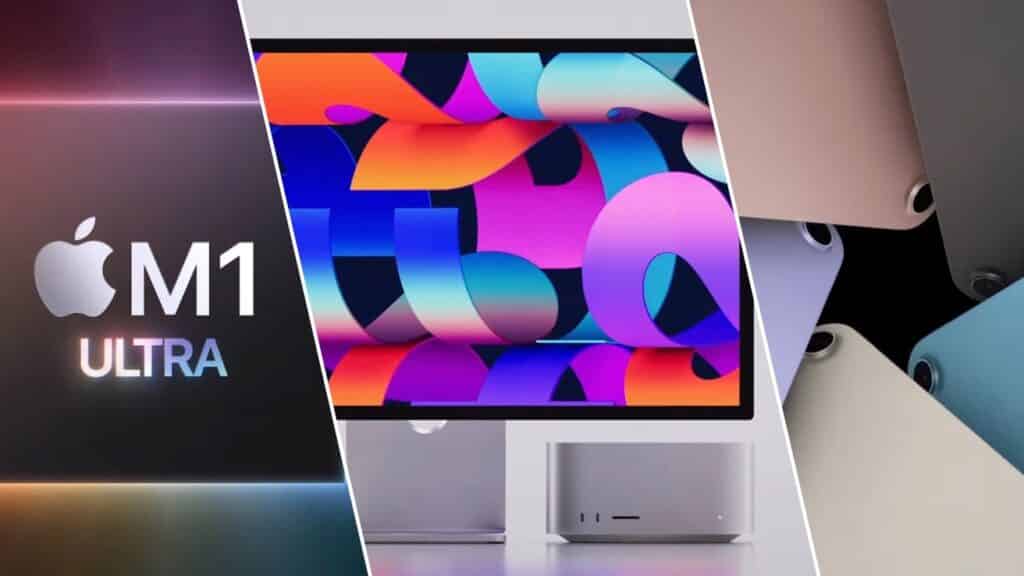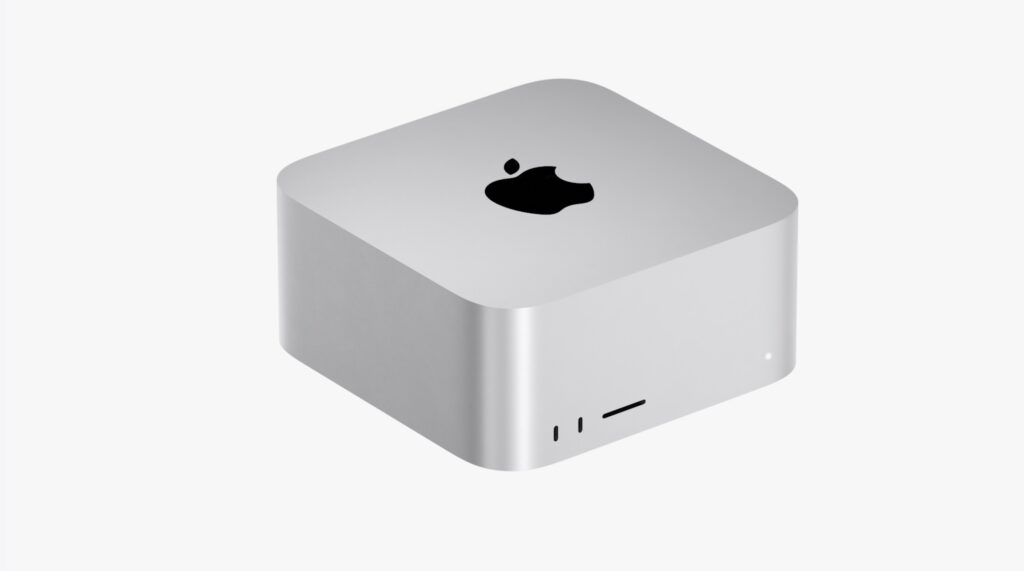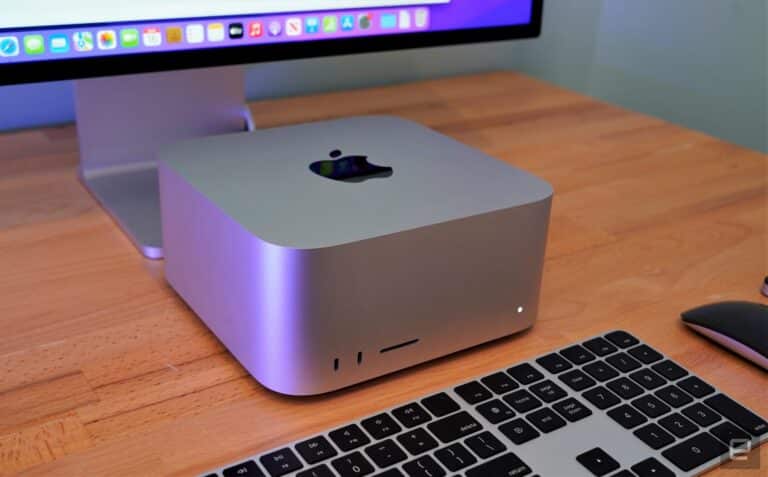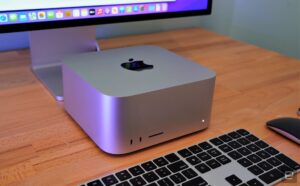Apple’s latest workstation, the Mac Studio, is aimed at creative workers. The Mac Studio, which resembles a Mac Mini that’s been to the gym, is a surprisingly little PC with a lot of power. Remember the M1 Max, which was used to control both MacBook Pro 14-inch & MacBook Pro 16-inch? The Mac Studio includes one with performance that will do even the most demanding projects, such as editing ultra-high-resolution videos in Final Cut Pro or dealing with multi-tracked audio initiatives in Logic Pro, a breeze.
Is there still a lack of power? The Mac Studio, on the other hand, can be modified to include the brand-new M1 Ultra chip. This is two M1 Max chips joined through low latency, fast broadband connector to form one enormous M1 Ultra chip with twice the cores, memory, and speed of the often uber-powerful M1 Max. When equipped with an M1 Ultra, the Mac Studio is among the most powerful workstations Apple has ever created, rivaling these most costly Mac Pro configurations while being compact enough to carry on a desk. With specs like these, the Mac Studio appears to be destined for the top but is Apple’s latest machine truly a practical purchase for the most creative professionals?
What you will see here?
Price and availability

The Mac Studio got available on March 18, so you can order one now for $1,999 on Apple’s website. For that price, you’ll get a Studio with a 10-core CPU, a 24-core GPU, a 16-core Neural Engine, 32GB of integrated memory, and a 512GB SSD.
The GPU in the M1 Max may be upgraded to 32 cores for an additional $200. You can also pay to upgrade the memory from 32GB to 64GB ($400) or the storage from 8 TB to 8 TB ($200 – $2,400). Although Apple claims that customers cannot upgrade the storage, a new breakdown has revealed the possibility of professional upgrades.
It will cost you a lot more if you need a Studio with one of the new M1 Ultra chips, which are effectively 2 M1 Max chips combined into one mega-chip. The entry-level M1 Ultra costs $3,999 and has a 20-core CPU, 48-core GPU, 32-core Neural Engine, 64GB of RA, and a 1TB SSD.
An updated variant with a 64-core GPU costs $4,999, so you can pay an additional $800 to quadruple the memory pool to 128GB. Increase storage capacity to 8TB ($400 – 2,200).
M1 CHIP
M1 ULTRA
Features

The raw power of the Mac Studio, particularly with the M1 Ultra, is its most notable feature. According to Apple, the Mac Studio with M1 Ultra has 3.8 times the CPU performance of the most costly 27-inch iMac.
It also outperforms a Mac Pro with a 16-core Intel Xeon processor by 90 percent, and a Mac Pro with a 28-core processor by up to 60%.
Those claims are astounding, but it gets better because the M1 Ultra is not only extremely powerful but also extremely efficient. Apple claims that the M1 Ultra has 90 percent higher multi-thread performance than a 16-core PC CPU while utilizing the same amount of power.
It can also outperform the highest-end PC GPU while using 200 watts less power. In fact, this implies cheaper operating expenses (particularly crucial in these days of growing energy costs and the M1 Ultra runs cooler. This allows Apple to make the Mac Studio practically silent in operation without any need for fans to spin up to keep cool, so it allows Apple to make it so small. You’ll find love with Mac Studio if you despise the look of huge, clunky tower PCs.
While Apple’s performance claims really do not add up (more about that later), there’s no denying that the Mac Studio is a capable little PC.
Design

And we said that Mac Studio seems like a beefed-up Mac Mini, we meant it looks like a beefed-up version of Apple’s tiniest PC while still being amazingly compact. It comprises a single aluminum chassis with a 7.7-inch square footprint as well as a height of 3.7 inches. It’s small enough to pick up with one hand, and in its actual size you can put it on a table and it won’t take up much space. It’s even possible to put it in a backpack and carry it about with you.
Despite being the same size, the M1 Ultra weighs somewhat more than the M1 Max (3.6kg vs. 2.7kg). This is due to the M1 Ultra’s usage of a big copper thermal module, while the M1 Max, which doesn’t run as hot, employs a thinner aluminum heatsink.
The Mac Studio also comes with a plethora of connectors, including 4 Thunderbolt 4 ports, a 10 gigabit Ethernet port, 2 USB ports, an HDMI port, and an audio jack on the back. Wi-Fi 6 and Bluetooth 5 are also available for wireless connections. There are two more USB-C ports on the front and an SD card slot, giving this one a terrific pick for photographers. The SD card slot & USB-C connections are on the show, making them simple to reach on a desk, however, the power button is on the back, and it’s awkward.
It’s one of the most attractive workstation PCs on the market, and its small size is quite astonishing given the Mac Studio’s capabilities.
Performance
The Mac Studio, unsurprisingly, provides exceptional performance, particularly for artistic workloads. We say ‘unsurprisingly’ because we’ve seen what M1 Max can do with MacBook Pro 14-inch & MacBook Pro 16-inch, and it’s no surprise that Mac Studio is on par with those machines when powered by the M1 Max, and greatly outclasses the two most recent MacBook Pros when powered by the M1 Ultra.
You can import high-resolution photographs into Photoshop in a matter of seconds and add effects and filters in real-time. The M1 Max and M1 Ultra’s ‘Neural Engine’ cores also enable the Mac Studio to leverage Photoshop’s artificial intelligence (AI) & machine learning technologies. These apps include one that recognizes the sky in your images and allows you to modify and even replace i. Onee that intelligently fills in the background to make it easy to eliminate things from a photo.
The beauty of these technologies is that they can speed up and simplify operations that were previously arduous and time-consuming, and Photoshop is a perfect example of what Ai/machine learning can do for creative workflows. The fact that Mac Studio can make use of these (and do so well) is a significant plus.
We used the Mac Studio to edit a difficult video project in Video Editing, which included numerous 8K sources in some moments. All of this while remaining very silent when in use. In Houdini, it also generated our 3D film really quickly. Unless you’re making Pixar-quality 3D animations, the Mac Studio is plenty powerful.
Gaming Performance

Many of the top PC games do not use Apple hardware, so they won’t run well (or ever) on the Studio. On the other hand, because Apple’s M1 processor can run iOS and iPadOS apps, you gain access to a plethora of games on Apple’s App Store, both in the Mac App Store as well as the iOS/iPad App Stores.
With all of the graphical settings turned up, the Mac Studio with M1 Ultra had no issue running them, averaging between 30-70 frames per second depending on the game.
Although this isn’t quite buttery-smooth high-framerate action, it’s enough to make the Studio a pretty competent gaming machine.
Mac Studio with M1 Ultra earned an average framerate of 38.85 frames per second. This was done with the game running full-screen @ 1440p resolution, which would have been the highest it could go at the time.
The Studio generates an average of 22.29 frames per second when you run the Rise of the Tomb Raider graphical test at native 5K resolution within all settings turned up to maximum. That’s not fantastic for a game that’s been out for seven years, but when you reduce the settings to Medium, the Studio was able to operate the game at a little better 31.65 frames per second.
Conclusion
The Mac Studio has a lot to offer, particularly in terms of performance and portability. If you’re looking for a powerful and compact workstation, you won’t find a better machine to accomplish your creative work.
Is it, however, a product that we would all recommend to others? No, that is not the case. Design unique instruments for a small group of people. If you need a tiny workstation and do a lot of creative work, this is your device.
However, if you don’t want the level of performance on offer here, many people won’t. You’d be better off opting for a less expensive option like the Mac mini. A laptop, such as the 14-inch MacBook Pro, maybe a better option. Suppose you need something to work on while traveling.
Read more:
- iMac 24 inch – Details, specs, features about all new Extraordinary MAC in 2021!
- MacBook Air vs iPad Pro: Which one you should get for yourself?
- Upgraded and powerful MacBook Air 2022 -What should we expect?
- Best Mac for gaming purposes you can choose from in 2025!
- Accessories you can get for a Mac Studio in 2025!
















